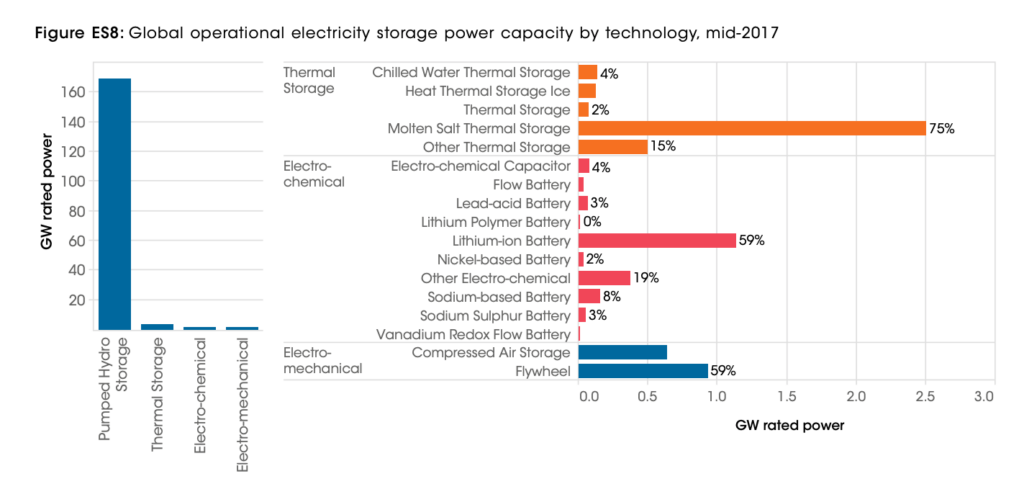Myth: Clean Power is Impossible Without Cheap Energy Storage
Fact: Energy storage (e.g. grid-scale batteries) can support the growth of clean power, and is expected to play an important role in the transition to clean power. But storage is not always necessary to increase clean power—a great deal of progress can be made on clean power without any storage at all.
Some believe adding new energy storage resources is a necessary pre-condition of adding clean power to your power system.
In fact, many power systems can safely and reliably integrate renewables without any new energy storage resources. Energy storage is expected to have an increasingly important role in enabling the integration of high shares of clean power by adding flexibility to your power system. It can and should be pursued where cost-effective. However, there are a variety of other affordable and easily implemented system flexibility options to explore before storage becomes necessary.
First, Read This
There are many types of energy storage technologies including pumped hydro storage, battery storage, and thermal storage. These technologies are mainly used to store excess generation for use in times of relatively high electricity demand. These solutions can be utility-scale or “behind-the-meter” (i.e. distributed or on-site).
“Storage technologies are used to store excess generation for use in times of relatively high demand. Energy storage can also provide value with or without high levels of renewable electricity penetration.
Text excerpt from Imperial College of London course: Incorporating Renewable Energy in Electricity Grids
- Thermal energy storage, for example, is used in a variety of applications such as heat storage from combined heat and power (CHP) plants for district heating, or ice storage for air conditioning in large commercial buildings.
- Pumped hydro storage is used for energy arbitrage (i.e. profiting from price changes) by pumping water to a higher elevation during periods with low electricity prices and releasing water through a turbine to produce electricity when electricity prices are higher.
- Grid-scale battery electric storage, which can be designed in a variety of electrochemical configurations, has fallen in cost in recent years and is increasingly deployed as a resource for various grid management applications, such as frequency regulation, provision of spinning reserves, and peak shaving. Battery storage costs are expected to continue falling, increasing the competitiveness of this solution.
- Other energy storage technologies include compressed air energy storage, high power supercapacitors, mechanical flywheels, and molten salt.”
Now, Read This
While these energy storage technologies can be used to enable and facilitate higher penetrations of clean power, they are not required to integrate renewables.
“Electricity system planners and operators can use storage technologies to increase system flexibility and facilitate higher penetrations of variable renewable electricity. To date, studies have found that most grids can achieve high levels of variable renewable electricity generation (e.g. up to 30% of annual electricity demand) through improvements to system operations.
At higher penetrations, however, integrating variable renewable resources may require new investments in flexibility resources if solar and wind generation do not align with electricity demand, and if the conventional generation fleet lacks the flexibility to balance the system. Grid-scale energy storage is an enabling technology that can facilitate higher penetrations of variable renewable energy on the grid by shifting the magnitude and timing of electricity supply, and by providing other essential reliability services for the system.”
Text excerpt from Imperial College of London course: Incorporating Renewable Energy in Electricity Grids
And This
There are many power system characteristics you can evaluate to determine whether and how much energy storage could be required to achieve your clean power goals.
“Battery storage is one of several technology options that can enhance power system flexibility and enable high levels of renewable energy integration. Studies and real-world experience have demonstrated that interconnected power systems can safely and reliably integrate high levels of renewable energy from variable renewable energy (VRE) sources without new energy storage resources. There is no rule-of-thumb for how much battery storage is needed to integrate high levels of renewable energy. Instead, the appropriate amount of grid-scale battery storage depends on system-specific characteristics, including:
- The current and planned mix of generation technologies
- Flexibility in existing generation sources • Interconnections with neighboring power systems
- The hourly, daily, and seasonal profile of electricity demand, and
- The hourly, daily, and seasonal profile of current and planned VRE.
In many systems, battery storage may not be the most economic resource to help integrate renewable energy, and other sources of system flexibility can be explored. Additional sources of system flexibility include, among others, building additional pumped-hydro storage or transmission, increasing conventional generation flexibility and changing operating procedures”
Text excerpt from NREL: Grid-Scale Battery Storage FAQ
Now, Read This
The deployment of battery storage technologies, particularly lithium-ion batteries, is increasing around the world as the cost of battery storage declines. Battery storage is expected to become more cost-effective in the years ahead.

And Look at This
The price of battery storage has decreased significantly for utility-scale projects in recent years from $600/MWh in 2015 to approximately $150/MWh in the beginning of 2020. These battery storage systems are becoming increasingly cost effective for providing short-term flexibility.

Ready to Take the Next Step?
- Research: What’s the average price of energy storage in your country?
- Find Out If Energy Storage Is the Right Option For You: Conducting a grid integration study can help you determine whether energy storage is a cost-effective and necessary flexibility option for your power system.
- Explore System Flexibility Measures: Interested in learning more about the system flexibility options that are right for your power system? Visit the Increase Power System Flexibility guide and learn more about energy storage.

